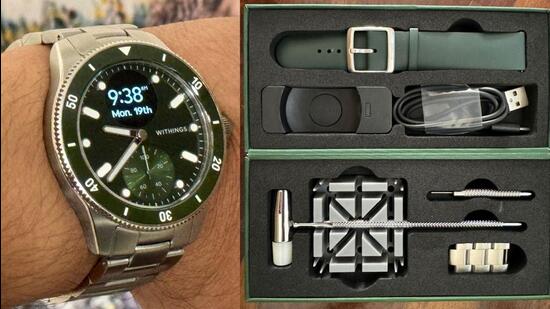It is a gap still waiting to be bridged. Watch purists would never give up conventional design dictating a sophisticated dial paired with either a metal link or a leather strap. In contrast, smartwatches as we’ve become used to over the years, they tend to often follow a template transcending sticker price. Down to the choice or round or rectangle designs and watch straps or bands. It is all too uninspiring at times. French company Withings has come the closest, to good effect, with the ScanWatch Nova. At first glance, you may mistakenly assume this is something crafted by the Swiss.
The method is simple. They’ve taken a design that resembles an analog divers’ watch (quickly glance at ones from Fossil and Seiko, for instance), and built on that with a bunch of activity and health tracking sensors that would be expected to dot a smartwatch landscape. The true smartwatch element comes a tiny, 0.63-inch circular OLED display residing within the watch dial. It all takes some getting used to, particularly the ease with which Withings has blended the conventional watch aesthetics with modern day smartwatch elements. Too good to be true?
Perhaps not. Withings seems to be leaving little to chance, with stainless steel watch case and the bezel adding a dash of ceramic as well. You have the choice of black, blue and green colours, and I tested the latter. The ScanWatch Nova gives you the choice of the metal links or the oyster band (this is essentially high-quality silicon), complete with a set of tools including a hammer, pin punch and holder. The toolkit is handy if you want to swap the metal for the oyster band or change the sizing of the former by adding or removing some links. No smartwatch, not even the Apple Watch Ultra 2 or the Samsung Galaxy Watch Ultra, follow through with such an elaborate offering. Mind you, these two are the pinnacle of smartwatches, for now.
Withings has given the ScanWatch Nova multiple sensors, including for temperature (it is called TempTech24/7 Module), heart rate, ECG, a high dynamic range accelerometer, a multi-wavelength PPG or photoplethysmogram which is used to detect the volume of blood, as well as an altimeter.
For a smartwatch experience that’s reliant on a screen as small as the ScanWatch Nova’s implementation, there is even greater importance of the companion app for your smartphone. The Withings app is quite slick to navigate with the home screen useful for quickly glancing at metrics, including the step count for the day, body temperature and the average heart rate. Note the “measure” tab, that’s where you’ll head to next for detailed metrics on activity, body, heart and sleep. The Heart section for instance tells me about the ECG, oxygen saturation readings or the body temperature.
For most readings, you are dependent on the watch making automatic readings, because the app also doesn’t have a way for you to manually invoke the more complex checks such as blood oxygen. However, from what I noticed, most metrics are auto collected very few minutes – for example, body temperature was collected at 8:28am, 8:33am, 8:38am and so on. ECG for example, requires you to complete the loop by keeping your hand on the watch face as well. You may be wondering how that works since you’ve no visibility of the screen then – the ScanWatch Nova gently vibrates once the 30 seconds are up, and the reading has been successfully logged.
This is also the point where you’re gently and persistently nudged towards signing up for the Withings+ subscription because some metrics are behind that paywall. The big pitch here is, something called the Health Improvement Score, which would provide guidance based on your activity. This costs ₹999 per month, and I’m not entirely sure if users would appreciate this resistance in experience after they’ve splurged top money for the watch. After all, the present market price hovers around ₹43,999.
Withings claims up to 30 days of battery life, and I can attest to having gotten through three weeks since I fully charged this on day one – and there’s still around 19% battery remaining. The ScanWatch Nova survives on mere sips of battery power. The charger that Withings has designed is perhaps the weakest link in an otherwise impressive package of attention to detail. The mechanism requires you to insert the watch into it, and the potential of the dial and bezel getting scratched will forever be a reason to worry. What was wrong with a simpler, magnetic implementation?
There is no bigger reason to buy the Withings ScanWatch Nova, than the conventional, analog watch design. Similar levels of attention to finer elements too. The tiny screen is useful to an extent, and you must navigate the vertically placed menu with the crown, for quickly glancing at the metrics or controlling some aspects of the watch. Building on that design is extensive health tracking, coupled with a really slick smartphone companion app. Perhaps not ideal for sleep tracking (or walking, unless you swap out the metal band), but delivers a wholistic health view.
